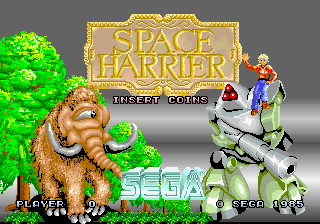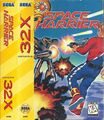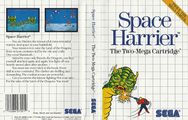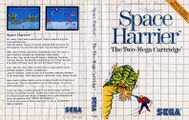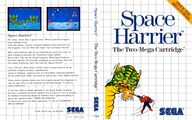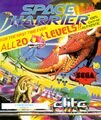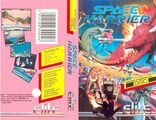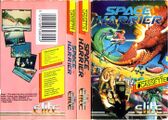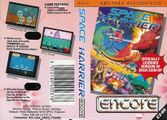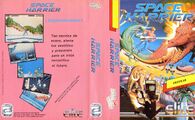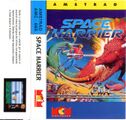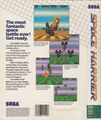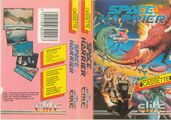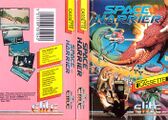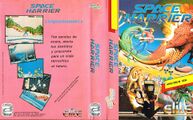Difference between revisions of "Space Harrier"
From Sega Retro
(→Master System Version: TW cart) |
|||
| Line 109: | Line 109: | ||
==Production Credits== | ==Production Credits== | ||
| + | {{multicol| | ||
| + | ===32X Version=== | ||
| + | '''Reprogrammed By:''' [[Rutubo Games]]<br/> | ||
| + | '''Programmer and Planner:''' [[Masatoshi Hashimoto|M.Hashimoto]] (Rutubo Games), [[Shinichirou Mukaigashira|S.Mukaigashira]] (Rutubo Games), K.Tsuneyoshi (Rutubo Games), T.Matsushima (Rutubo Games), M.Mishima (Rutubo Games)<br/> | ||
| + | '''Thanks:''' Y.Kenji (Rutubo Games), T.Maeda (Rutubo Games)<br/> | ||
| + | '''Special Thanks:''' [[Mamoru Shigeta|M.Shigeta]], [[Hiroshi Aso|H.Aso]], [[Osamu Sato|O.Sato]], Y.Ohoka, S.Yonekura, H.Lee, [[Kotaro Hayashida|K.Hayashida]]<br/> | ||
| + | '''Presented by:''' [[Sega|Sega Enterprises Ltd.]]<br/> | ||
| + | |||
===Master System Version=== | ===Master System Version=== | ||
: '''PC Unit''' | : '''PC Unit''' | ||
| Line 137: | Line 145: | ||
'''Used Machine:''' CZ-802C, PC-8801MK2MR<br/> | '''Used Machine:''' CZ-802C, PC-8801MK2MR<br/> | ||
| − | === | + | ===Sharp X6800 Version=== |
| − | ''' | + | '''Main Programmer:''' T. Matsushima<br/> |
| − | ''' | + | '''Music Driver:''' Masatoshi Yoshizawa<br/> |
| − | ''' | + | '''Music Editor:''' Yu-You<br/> |
| − | ''' | + | '''Sound Effector:''' YK-2, Yu-You, T. Matsushima<br/> |
| − | ''' | + | '''Graphic Coding:''' T. Matsushima<br/> |
| + | '''Management:''' Taro Tada<br/> | ||
| + | '''Test Player:''' Ichiro Tezuka, Akira Yamashita, Akira Hibiki, Exchanger<br/> | ||
| + | '''Special Thanks To:''' Bridal Naniwa, Tomoko Ohtsuka, Sega Research and Development Dept.<br/> | ||
| + | [[Dempa]] Micom Soft<br/> | ||
| + | Sega - Space Harrier - X 68000 | ||
| + | }} | ||
==Manuals== | ==Manuals== | ||
Revision as of 11:06, 24 June 2012
| Space Harrier | |||||||||
|---|---|---|---|---|---|---|---|---|---|
| System(s): Sega Space Harrier Hardware, Acorn Electron, Amiga, Amstrad CPC, Atari ST, Commodore 16, Commodore 64, Game Gear, NEC PC-6001, NEC PC-8801, Nintendo Famicom, Sega 32X, Sega Master System, Sharp MZ, Sharp X1, Sharp X68000, TurboGrafx-16, Virtual Console, ZX Spectrum | |||||||||
| Publisher: Sega, Dempa, Elite Systems, Mindscape (US), Takara, NEC | |||||||||
| Developer: Sega AM2, Sega, Dempa, Elite | |||||||||
| Genre: Shoot-'em-Up | |||||||||
| |||||||||
|
CERO
Missing Parameter! |
Space Harrier (スペースハリアー) is a rail shoot 'em up game developed by Yu Suzuki and Sega AM2 which makes use of Super Scaler technology. It is one of many A-list arcade games developed by Sega during the 1980s, placing Sega firmly on the map and inspiring numerous sequels, starting with Space Harrier 3D.
In Space Harrier the player controls a blonde haired man with a jetpack and laser shooting at various objects and enemies while making sure not to get hit. There are 18 levels, each with a boss at the end, excluding the 5th and 12th levels which are bonus stages, and the 18th which is essentially a boss rush. The game has a third person perspective, making it one of the first "rail shooters" to be conceived.
Space Harrier and its sequels are set in the "Fantasy Zone", the same setting as the arcade game with the same name. This relationship was explored further with the Sharp X68000 port of Fantasy Zone, which includes a Space Harrier level, and the cancelled TurbografX-16 title Space Fantasy Zone, which was a hybrid between the two games.
Contents
- 1 Ports and Rereleases
- 2 Production Credits
- 3 Manuals
- 4 Gallery
- 5 Artwork
- 6 Physical Scans
- 6.1 Arcade Version
- 6.2 32X Version
- 6.3 Master System Version
- 6.4 Game Gear Version
- 6.5 Amiga Version
- 6.6 Amstrad CPC Version
- 6.7 Atari ST Version
- 6.8 Commodore 64 Version
- 6.9 DOS Version
- 6.10 FM77 AV Version
- 6.11 NES Version
- 6.12 PC-8801 Version
- 6.13 Sharp X1 Version
- 6.14 Sharp X68000 Version
- 6.15 Turbografx-16 Version
- 6.16 ZX Spectrum Version
- 7 External Links
Ports and Rereleases
Space Harrier is currently the most ported Sega game in history, being released for numerous home computers and consoles including the Acorn Electron, Amiga, Amstrad CPC, Atari ST, Commodore 16, Commodore 64, NEC PC-6001, NEC PC-8801, Nintendo Famicom, Sega 32X, Sega Game Gear, Sega Master System, Sharp MZ, Sharp X1, Sharp X68000, TurboGrafx-16 and ZX Spectrum. It has also been included in numerous compilations, including the Game Boy Advance's Sega Arcade Gallery, the PlayStation 2's Sega Classics Collection and the PlayStation 3/Xbox 360's Sega Mega Drive Ultimate Collection. A remake and port was also released in Japan under the Sega Ages 2500 label.
The Sega Master System port was handled by Sega AM4, featuring a final boss which was absent from the Arcade version. This version went on to inspire the exclusive Space Harrier 3D, and was one of the most popular games for the system during its lifespan. Most of the western computer ports were handled by Elite, and, like the Master System game, had to sacrifice the smooth scaling and framerate due to weaker hardware. The Japanese-only X68000 version would the only home copy of Space Harrier to feature perfect scaling until a Sega 32X port showed up in 1994, and later a Sega Saturn port (Sega Ages Vol.2 Space Harrier in 1996). Surprisingly the game was ported to extremely weak hardware such as the NEC-6001 and Sharp MZ computers, forcing the developers to reduce most of the graphics to coloured squares. Despite this, the digitized voices often remained in the game.
Space Harrier was even ported to the Nintendo Famicom by Takara, despite the console being in direct competition with Sega's Master System at the time. Squaresoft's The NES game The 3D Battles of WorldRunner is often considered to have been heavily inspired by Space Harrier also.
The game was included as a minigame in both Shenmue and Shenmue II, and more recently the Master System version of the game was made available via the Wii's Virtual Console service in 2008, followed by a Virtual Console Arcade release a year later.
Production Credits
32X Version
Reprogrammed By: Rutubo Games
Programmer and Planner: M.Hashimoto (Rutubo Games), S.Mukaigashira (Rutubo Games), K.Tsuneyoshi (Rutubo Games), T.Matsushima (Rutubo Games), M.Mishima (Rutubo Games)
Thanks: Y.Kenji (Rutubo Games), T.Maeda (Rutubo Games)
Special Thanks: M.Shigeta, H.Aso, O.Sato, Y.Ohoka, S.Yonekura, H.Lee, K.Hayashida
Presented by: Sega Enterprises Ltd.
Master System Version
- PC Unit
Directed by: Berial Mut 743
Produced by: Nitta Tai Yuji
Screenplay by: Nitta Tai Yuji, Berial Mut 743, Tamo, Koshihikari
Story by: Berial Mut 743
Editor: Tamo, Koshihikari
Art Director: Fuuuuuk
Art Designer: Mayu, Col Khadafy, Matilda Yoko, Sukeban Tamun, 3712 SK
Music Arranger: Bo
Proposed by: Nitta Tai Yuji
Special Thanks: Arcade Unit, Yu, Cota, Hiro, Bin Chan, Chisuke, Eiro, Pideshi, Kan, Shy Guy Aso, Sant
Present from: Sega
Amiga Version
Program: Richard Frankish
Graphics: M Sportouch
Music: Jas C Brooke
Copyright 1989 Elite Systems Ltd
Sharp X1 Version
Main Program: K. Komiyama
Character Arrange: K. Komiyama
Sound Arrange: K. Komiyama
Other Data: K. Komiyama
Special Thanks: K. Ishida, Naniwa/Dempa
Used Machine: CZ-802C, PC-8801MK2MR
Sharp X6800 Version
Main Programmer: T. Matsushima
Music Driver: Masatoshi Yoshizawa
Music Editor: Yu-You
Sound Effector: YK-2, Yu-You, T. Matsushima
Graphic Coding: T. Matsushima
Management: Taro Tada
Test Player: Ichiro Tezuka, Akira Yamashita, Akira Hibiki, Exchanger
Special Thanks To: Bridal Naniwa, Tomoko Ohtsuka, Sega Research and Development Dept.
Dempa Micom Soft
Sega - Space Harrier - X 68000
Manuals
32X Version
Gallery
Artwork
Physical Scans
Arcade Version
Template:ScanflyerTemplate:Scanflyer
32X Version
| Sega Retro Average | |||||||||||||||||||||||||||||||||||||||||||||||||||||||||||||||||||||||||||||||||||||||||||||||||||||||||||||||||||||||||||||||||||||||||||
|---|---|---|---|---|---|---|---|---|---|---|---|---|---|---|---|---|---|---|---|---|---|---|---|---|---|---|---|---|---|---|---|---|---|---|---|---|---|---|---|---|---|---|---|---|---|---|---|---|---|---|---|---|---|---|---|---|---|---|---|---|---|---|---|---|---|---|---|---|---|---|---|---|---|---|---|---|---|---|---|---|---|---|---|---|---|---|---|---|---|---|---|---|---|---|---|---|---|---|---|---|---|---|---|---|---|---|---|---|---|---|---|---|---|---|---|---|---|---|---|---|---|---|---|---|---|---|---|---|---|---|---|---|---|---|---|---|---|---|---|
|
| 66 | |
|---|---|
| Based on 27 reviews | |
Master System Version
| Sega Retro Average | ||||||||||||||||||||||||||||||||||||||||||||||||||||||||||||||||||||||||||||||||||||
|---|---|---|---|---|---|---|---|---|---|---|---|---|---|---|---|---|---|---|---|---|---|---|---|---|---|---|---|---|---|---|---|---|---|---|---|---|---|---|---|---|---|---|---|---|---|---|---|---|---|---|---|---|---|---|---|---|---|---|---|---|---|---|---|---|---|---|---|---|---|---|---|---|---|---|---|---|---|---|---|---|---|---|---|---|
|
| 80 | |
|---|---|
| Based on 16 reviews | |
Game Gear Version
| Sega Retro Average | ||||||||||||||||||||||||||||||||||||||||||||||||||||||||||||||||||||||||||||||||||||||||||||||||||||||||||||||||||||||||||||
|---|---|---|---|---|---|---|---|---|---|---|---|---|---|---|---|---|---|---|---|---|---|---|---|---|---|---|---|---|---|---|---|---|---|---|---|---|---|---|---|---|---|---|---|---|---|---|---|---|---|---|---|---|---|---|---|---|---|---|---|---|---|---|---|---|---|---|---|---|---|---|---|---|---|---|---|---|---|---|---|---|---|---|---|---|---|---|---|---|---|---|---|---|---|---|---|---|---|---|---|---|---|---|---|---|---|---|---|---|---|---|---|---|---|---|---|---|---|---|---|---|---|---|---|---|
|
| 72 | |
|---|---|
| Based on 24 reviews | |
Amiga Version
| Sega Retro Average | ||||
|---|---|---|---|---|
|
| N/A | |
|---|---|
| Based on 0 reviews | |
Amstrad CPC Version
| Sega Retro Average | ||||
|---|---|---|---|---|
|
| N/A | |
|---|---|
| Based on 0 reviews | |
Atari ST Version
| Sega Retro Average | ||||
|---|---|---|---|---|
|
| N/A | |
|---|---|
| Based on 0 reviews | |
Commodore 64 Version
| Sega Retro Average | ||||
|---|---|---|---|---|
|
| N/A | |
|---|---|
| Based on 0 reviews | |
DOS Version
FM77 AV Version
NES Version
PC-8801 Version
| PC-8801, JP |
|---|
| <div style="margin:auto; max-width:Expression error: Unexpected < operator.px">
320x80px Cover
|
Sharp X1 Version
Sharp X68000 Version
Turbografx-16 Version
| Sega Retro Average | ||||
|---|---|---|---|---|
|
| N/A | |
|---|---|
| Based on 0 reviews | |
| TurboGrafx-16, US |
|---|
| <div style="margin:auto; max-width:Expression error: Unexpected < operator.px">
320x120px Cover
|
50x50px Cart |
| TurboGrafx-16, JP |
|---|
| <div style="margin:auto; max-width:Expression error: Unexpected < operator.px">
320x80px Cover
|
50x50px Cart |
ZX Spectrum Version
| Sega Retro Average | ||||
|---|---|---|---|---|
|
| N/A | |
|---|---|
| Based on 0 reviews | |
External Links
- Sega of Japan Virtual Console pages: Master System, Arcade
| Space Harrier series |
|---|
| Space Harrier (JP home computers | Elite versions | Sega Ages Vol. 2 | mobile | 3D) (1986) | Space Harrier 3D (1988) | Space Harrier II (Electronic) (1988) | Planet Harriers (2001) | Typing Space Harrier (2002) | Sega Ages 2500 Series Vol. 4: Space Harrier (2003) |
| Albums |
| Yu Suzuki Produce Hang On/Space Harrier (1997) | Planet Harriers The Original Soundtrack (2001) | Space Harrier II: Space Harrier Complete Collection Original Soundtrack (2005) |
| Other Media |
| Space Harrier (video) (1987) | Space Harrier: White Dragon no Yuusha (1988) |
- ↑ Beep! MegaDrive, "January 1995" (JP; 1994-12-08), page 26
- ↑ CD Consoles, "Mars 1995" (FR; 1995-xx-xx), page 118
- ↑ Consoles +, "Mars 1995" (FR; 1995-0x-xx), page 104
- ↑ Famitsu, "1994-12-09" (JP; 1994-11-25), page 39
- ↑ GamePro, "April 1995" (US; 1995-xx-xx), page 60
- ↑ Games World: The Magazine, "March 1995" (UK; 1995-01-26), page 13
- ↑ Joypad, "Mars 1995" (FR; 1995-0x-xx), page 79
- ↑ MAN!AC, "02/95" (DE; 1995-01-11), page 44
- ↑ Mega, "December 1994" (UK; 1994-11-30), page 30
- ↑ Mega Fun, "02/95" (DE; 1995-01-18), page 105
- ↑ Mega Play, "February/March 1995" (US; 1995-0x-xx), page 49
- ↑ Mean Machines Sega, "March 1995" (UK; 1995-01-30), page 88
- ↑ Player One, "Mars 1995" (FR; 1995-0x-xx), page 104
- ↑ Play Time, "2/95" (DE; 1995-01-04), page 104
- ↑ Power Up!, "Saturday, April 22, 1995" (UK; 1995-04-22), page 1
- ↑ Saturn Fan, "1995 February" (JP; 1995-01-07), page 34
- ↑ 17.0 17.1 Score, "Duben 1995" (CZ; 1995-04-01), page 46
- ↑ Sega Magazine, "January 1995" (UK; 1994-12-15), page 86
- ↑ Sega Power, "February 1995" (UK; 1994-12-15), page 58
- ↑ Sega Pro, "April 1996" (UK; 1996-02-28), page 27
- ↑ Sega Pro, "February 1995" (UK; 1994-12-29), page 67
- ↑ Sega Saturn Magazine, "September 1995" (JP; 1995-08-08), page 84
- ↑ Super Juegos, "Enero 1995" (ES; 199x-xx-xx), page 54
- ↑ Todo Sega, "Febrero 1995" (ES; 1995-0x-xx), page 35
- ↑ Ultimate Future Games, "February 1995" (UK; 1995-01-01), page 86
- ↑ Video Games, "2/95" (DE; 1995-01-18), page 91
- ↑ VideoGames, "March 1995" (US; 1995-02-xx), page 65
- ↑ Complete Guide to Consoles, "" (UK; 1989-10-16), page 71
- ↑ Complete Guide to Consoles, "Volume IV" (UK; 1990-11-xx), page 107
- ↑ The Complete Guide to Sega, "" (UK; 1991-05-xx), page 62
- ↑ Computer Action, "Juli/August 89" (DK; 1989-0x-xx), page 34
- ↑ Console XS, "June/July 1992" (UK; 1992-04-23), page 145
- ↑ The Games Machine, "Settembre 1988" (IT; 1988-09-15), page 62
- ↑ Micromanía (segunda época), "Mayo 1990" (ES; 1990-0x-xx), page 66
- ↑ Mean Machines Sega, "October 1992" (UK; 1992-09-xx), page 136
- ↑ Power Play, "Ausgabe 1" (DE; 1987-11-27), page 97
- ↑ S: The Sega Magazine, "April 1990" (UK; 1990-03-01), page 9
- ↑ Sega Power, "October 1991" (UK; 1991-09-05), page 59
- ↑ Sega Pro, "April 1992" (UK; 1992-03-19), page 29
- ↑ Sega Pro, "April 1993" (UK; 1993-03-11), page 72
- ↑ Soft, "" (DK; 1988-02-18), page 31
- ↑ Tilt, "Décembre 1987" (FR; 1987-1x-xx), page 106
- ↑ Ação Games, "Fevereiro 1992" (BR; 1992-02-xx), page 42
- ↑ Beep! MegaDrive, "December 1991" (JP; 1991-11-08), page 40
- ↑ Console XS, "June/July 1992" (UK; 1992-04-23), page 149
- ↑ Computer & Video Games, "April 1992 (Go! Issue 6)" (UK; 1992-03-15), page 8
- ↑ Mean Machines: The Essential Sega Guide, "" (UK; 1993-11-18), page 170
- ↑ Famitsu, "1991-12-13" (JP; 1991-11-29), page 40
- ↑ GamePro, "December 1991" (US; 1991-xx-xx), page 126
- ↑ Génération 4, "Janvier 1992" (FR; 199x-xx-xx), page 155
- ↑ Hippon Super, "January 1992" (JP; 1991-12-04), page 93
- ↑ Hobby Consolas, "Diciembre 1991" (ES; 1991-1x-xx), page 50
- ↑ Joystick, "Janvier 1992" (FR; 199x-xx-xx), page 144
- ↑ Mega Force, "Janvier 1992" (FR; 1992-01-15), page 44
- ↑ Micromanía (segunda época), "Marzo 1992" (ES; 1992-0x-xx), page 35
- ↑ Mean Machines Sega, "October 1992" (UK; 1992-09-xx), page 143
- ↑ Player One, "Février 1992" (FR; 1992-xx-xx), page 80
- ↑ Play Time, "4/92" (DE; 1992-03-04), page 84
- ↑ Sega Power, "May 1992" (UK; 1992-04-02), page 47
- ↑ Sega Pro, "March 1992" (UK; 1992-02-20), page 59
- ↑ Sega Pro, "April 1993" (UK; 1993-03-11), page 74
- ↑ Sega Force Mega, "January 1994" (UK; 1993-12-16), page 78
- ↑ Sega Force, "March 1992" (UK; 1992-02-20), page 54
- ↑ Sega Saturn Magazine, "September 1995" (JP; 1995-08-08), page 88
- ↑ User, "Noémvrios 1992" (GR; 1992-1x-xx), page 66
- ↑ Video Games, "6/92" (DE; 1992-05-29), page 123
- Pages using duplicate arguments in template calls
- No players field
- NES games
- Old content rating field
- Use romtable template
- All games
- Pages with broken file links
- Old-style rating (consolesplus)
- Rating without source
- Old-style rating (joypad)
- Old-style rating (maniac)
- Old-style rating (playerone)
- Update ratings template
- 3 old ratings
- Old-style rating (gamesmachine)
- Old-style rating (micromania)
- Old-style rating (sfuk)
- Old-style rating (tilt)
- 5 old ratings
- Old-style rating (hobbyconsolas)
- 1 old ratings
- Old-style rating (ace)
- Old-style rating (cvg)
- 2 old ratings
- No ratings
- Space Harrier (franchise)
- Space Harrier Hardware Games
- Acorn Electron Games
- Amiga Games
- Amstrad CPC Games
- Atari ST Games
- Commodore 16 Games
- Commodore 64 Games
- Fujitsu FM-7 Games
- NEC PC-6001 Games
- NEC PC-8801 Games
- NES Games
- Sharp MZ Games
- Sharp X1 Games
- Sharp X68000 Games
- TurboGrafx-16 Games
- ZX Spectrum Games
- Virtual Console Games
- Space Harrier
